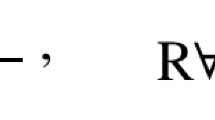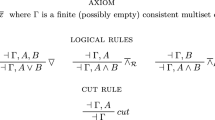Abstract
We devise a method for generalizing proofs in Gentzen’s sequent calculus \(\mathrm {LK}\), presented in a typed \(\lambda \)-calculus flavor. A constrained version \(\mathrm {LK}^{{{\mathrm {c}}}}\) of the calculus is introduced, aiming at collecting a second order constraint ensuring that all the inference steps occurring in a proof are syntactically correct. A semantics is provided for \(\mathrm {LK}^{{{\mathrm {c}}}}\), extending the standard semantics of \(\mathrm {LK}\). It is then established that \(\mathrm {LK}\)-proofs correspond to \(\mathrm {LK}^{{{\mathrm {c}}}}\)-proofs with valid constraint thanks to the use of eigenterms replacing \(\mathrm {LK}\)’s eigenvariables. Next, a lifting theorem shows how a valid \(\mathrm {LK}^{{{\mathrm {c}}}}\)-proof can be lifted to a most general proof, yielding a non-trivial constraint together with a solution. An algorithm is then provided that minimizes this solution of the constraint. The result, applied to the most general proof, yields a valid proof that translates to an \(\mathrm {LK}\)-proof more general than the initial one. Finally, clues are given for extending this method to other logics with due care on proof lifting.





Similar content being viewed by others
Notes
We assume w.l.o.g. that \(D \cap (\mathcal {C}\cup \mathcal {V})= \emptyset \) and that D contains no non-atomic terms in \(\mathcal {T}_D\).
More precisely on a special kind of formulæ called “matrices”.
Note that the \(\mathcal {X}_i\)’s are not part of these meta-variables.
These constants cannot be generalized simply because there is no variable of the corresponding types. The equality predicate could be generalized if its specific properties are not used in the proof, i.e., if no paramodulation inference is applied on it. Of course, if no \(\wedge \)-rule is applied on a formula \((\wedge \;t_1\, t_2)\) then it can be generalized by a variable of type \(\mathbf {o}\).
In particular, if \(v\in \{\forall ,\exists \}\) then \(m=1\) and \(z_1\) has type \({\varvec{\i }}^{n+1}\rightarrow \mathbf {o}\). If v is a binary connective then \(m=2\) since t has \(\mathcal {V}\)-type.
Another way to do this is to allow principal formulæ to occur anywhere in the conclusions of the rules. For instance, the (\(\lnot \)-L) rule would be \(\displaystyle \frac{\varGamma ,\varSigma \vdash \varDelta ,\phi }{\varGamma ,\lnot \phi ,\varSigma \vdash \varDelta }.\)
References
Andrews, P.B.: Resolution in type theory. J. Symb. Log. 36(3), 414–432 (1971)
Baaz, M., Wojtylak, P.: Generalizing proofs in monadic languages. Ann. Pure Appl. Log. 154(2), 71–138 (2008)
Caferra, R., Zabel, N.: Building models by using tableaux extended by equational problems. J. Log. Comput. 3, 3–25 (1993)
Cavagnetto, S.: The lengths of proofs: Kreisel’s conjecture and Gödel’s speed-up theorem. J. Math. Sci. 158(5), 689–707 (2009)
Dowek, G.: Higher-order unification and matching. In: Robinson, A., Voronkov, A. (eds.) Handbook of Automated Reasoning, Volume II, Chapter 16, pp. 1009–1062. Elsevier Science, New York (2001)
Dowek, G., Hardin, T., Kirchner, C.: Theorem proving modulo. J. Autom. Reason. 31(1), 33–72 (2003)
Farmer, W.M.: A unification-theoretic method for investigating the \(k\)-provability problem. Ann. Pure Appl. Log. 51(3), 173–214 (1991)
Felty, A.P., Howe, D.J.: Generalization and reuse of tactic proofs. In: Pfenning, F. (eds.) LPAR, Volume 822 of Lecture Notes in Computer Science, pp. 1–15. Springer, Berlin (1994)
Giese, M.: Incremental closure of free variable tableaux. In Goré, R., Leitsch, A., Nipkow, T. (eds.) Proceedings of International Joint Conference on Automated Reasoning, Siena, Italy, number 2083 in LNCS, pp. 545–560. Springer (2001)
Hagiya, M.: A typed lambda-calculus for proving-by-example and bottom-up generalization procedure. Theor. Comput. Sci. 137(1), 3–23 (1995)
Hetzl, S.: A sequent calculus with implicit term representation. In Dawar, A., Veith, H. (eds.) Computer Science Logic, volume 6247 of Lecture Notes in Computer Science, pp. 351–365. Springer, Berlin (2010)
Johnsen, E.B., Lüth, C.: Theorem reuse by proof term transformation. In: Slind, K., Bunker, A., Gopalakrishnan, G. (eds.) TPHOLs, volume 3223 of Lecture Notes in Computer Science, pp. 152–167. Springer (2004)
Krajíček, J., Pudlák, P.: The number of proof lines and the size of proofs in first order logic. Arch. Math. Log. 27, 69–84 (1988)
Lugiez, D.: Positive and negative results for higher-order disunification. J. Symb. Comput. 20(4), 431–470 (1995)
Melis, E., Whittle, J.: Analogy in inductive theorem proving. J. Autom. Reason. 22(2), 117–147 (1999)
Miller, D.: Proofs in Higher-Order Logic. PhD thesis, Carnegie-Mellon University (1983). Technical report: MS-CIS-83-37
Miller, D.: A compact representation of proofs. Stud. Log. 46(4), 347–370 (1987)
Miller, D.: Unification under a mixed prefix. J. Symb. Comput. 14(4), 321–358 (1992)
Moser, G., Zach, R.: The epsilon calculus (tutorial). In: Baaz, M., Makowsky, J.A. (eds.) Computer Science Logic, 17th International Workshop, CSL 2003, 12th Annual Conference of the EACSL, and 8th Kurt Gödel Colloquium, KGC 2003, Vienna, Austria, August 25–30, 2003, Proceedings, volume 2803 of Lecture Notes in Computer Science, p. 455. Springer, (2003)
Moser, G., Zach, R.: The epsilon calculus and Herbrand complexity. Stud. Log. 82(1), 133–155 (2006)
Parikh, R.J.: Some results on the length of proofs. Trans. Am. Math. Soc. 177, 29–36 (1973)
Peltier, N.: Pruning the search space and extracting more models in tableaux. Log. J. IGPL 7(2), 217–251 (1999)
Pfenning, F.: Unification and anti-unification in the calculus of constructions. In: Proceedings of Sixth Annual IEEE Symposium on Logic in Computer Science, 1991. LICS ’91, pp. 74–85 (1991)
Rümmer, P.: A constraint sequent calculus for first-order logic with linear integer arithmetic. In: Cervesato, I., Veith, H., Voronkov, A. (eds.) Logic for Programming, Artificial Intelligence, and Reasoning, volume 5330 of Lecture Notes in Computer Science, pp. 274–289. Springer, Berlin (2008)
Takeuti, G.: Proof Theory, 2nd edn. North Holland, New York (1987)
Walther, C., Kolbe, T.: Proving theorems by reuse. Artif. Intell. 116(1–2), 17–66 (2000)
Zach, R.: The practice of finitism: epsilon calculus and consistency proofs in Hilbert’s program. Synthese 137(1–2), 211–259 (2003)
Acknowledgments
We thank the anonymous referees for their helpful comments and references.
Author information
Authors and Affiliations
Corresponding author
Ethics declarations
Conflicts of interest
The authors declare that they have no conflict of interest.
Rights and permissions
About this article
Cite this article
Boy de la Tour, T., Peltier, N. Proof Generalization in \(\mathrm {LK}\) by Second Order Unifier Minimization. J Autom Reasoning 57, 245–280 (2016). https://doi.org/10.1007/s10817-016-9367-3
Received:
Accepted:
Published:
Issue Date:
DOI: https://doi.org/10.1007/s10817-016-9367-3




